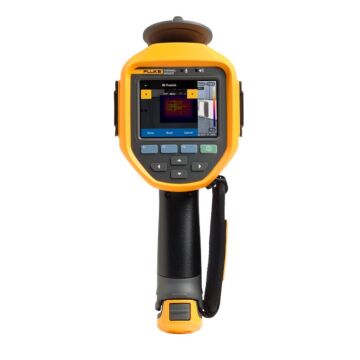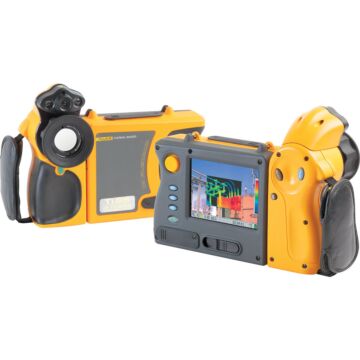
Digital thermal imaging cameras have established themselves as invaluable tools for building safety inspections. Thermal imaging cameras such as forward-looking infrared (FLIR) cameras perform noncontact temperature measurements to detect anomalous heat patterns in buildings. They can be used, for example, to find energy-wasting leaks in construction or gaps in electrical insulation. They can also provide heat signatures that reveal the condition of a power generator or motor in factories and production plants. Since some building inspections are performed in potentially dangerous environments, a safe imaging camera can provide a sharp vision of a safe building. But choosing the right digital or thermal imaging camera for a job requires an understanding of how these instruments work and some insight into some of the more important performance specifications. The right camera can pack a great deal of safety inspection into a portable handheld instrument.
Thermal imaging cameras use infrared (IR) illumination and detection to study how heat radiates from a target, such as the surface of pipe. They can detect temperature differentials (ΔT) such as between the environmental or room temperature and the surface temperature of pipes carrying water. While they cannot make measurements underground or behind walls, they can measure ΔT within a structure or even on the surface of a device under test (DUT) such as a motor in search of “hot spots” or problem areas that may lead to failures or shortened operating lifetimes. By measuring temperature rises across building structures, problems can be avoided which might otherwise lead to fires and safety hazards.
When considering thermal imaging cameras for a site inspection, a handful of specifications can be compared. The camera should have thermal sensitivity of 100 degrees millikelvin (100 mK) or better (lower temperatures indicate better sensitivity) with a thermal field of view (FOV) of 20 deg. or more. It should provide IR resolution of 120 × 120 pixels or better. The camera should have operational and storage temperature ranges matching or exceeding the environment in which it will be used


Mechanically, the camera should be designed with the mobility and portability that enables one-handed operation for use of use in tight spaces. A thermal imaging camera designed for arduous work should have a drop rating of at least 6.5 ft. to withstand rough handling. A thermal imaging camera designed for long-term building inspections should be housed in an enclosure that meets Ingress Protection (IP) IP54 dust and splash protection. The means it is designed to protect against solid waste such as dust and liquids from entering the enclosure. It can operate accurately and effectively in dust-filled environments and can withstand fluids splashed on the outside of the housing from all directions.
Carrying a Camera
The latest thermal imaging cameras provide extensive measurement capabilities in compact enclosures, designed to enable simple, one-handed use when performing a building inspection. A choice of thermal imaging camera should consider its digital processing power and memory for storing test data, available software in support of the camera, and safety certifications, especially if the camera will be used in hostile inspection areas.
As an example, the FLIR® E8 Pro thermal imaging camera is equipped with a power grip for ease of one-handed use. It operates at temperatures from -4 to +1022°F with thermal sensitivity of better than 50 mK (better than 0.09°F or 0.05°C). The camera has a 9-Hz imaging frequency with 320 × 240 pixel thermal resolution. It features patented FLIR MSX® Multi-Spectral Dynamic Imaging technology and Ignite Cloud secure cloud-based data storage with built-in light-emitting-diode (LED) lamp to brighten darkened visual inspections.
The Fluke Ti480 PRO thermal imager, part of the Fluke Professional Series of IR cameras, has 60-Hz imaging frequency with 640 x 480 pixel resolution. With its SuperResolution capability, it can combine multiple images to raise the resolution to 1280 × 960 pixels. With patent-pending IR-Fusion technology, visible and IR images are combined for greater detail. Designed for ease of use, its touch-screen display and multiple Delta-T markers help speed ΔT measurements across wide areas, with better than 25 mK (better than 0.025°C) thermal sensitivity. The camera operates on a rechargeable Li-ion battery pack. It has a minimum focus distance of about 6 in. while delivering spatial resolution of 0.93 mRad at greater distances. Compatible with the company’s IR smart lenses, which it recognizes upon installation without need for calibration, it is supported by free downloadable Fluke Connect® desktop software.
The FLIR E96 is a compact pistol-grip camera which can perform safe inspection of hazardous targets, such as high-voltage supplies, from a distance. It works with FLIR’s FlexView™ dual and wide FOV lenses to provide greater flexibility on visual inspections. With a 24-deg. lens, it achieves better than 40 mK thermal sensitivity with 640 × 480 pixel thermal imaging resolution. The measurement accuracy is ±2% or ±3.6°F. Available with 14-, 24-, and 42-deg. AutoCal lenses, the lenses feature USB-A and USB-C interfaces and are automatically recognized by the camera upon installation so that calibration is not required.
Also from FLIR, the T650SC is a thermal imaging camera with 640 × 480 pixel thermal imaging resolution. It has a built-in digital camera for high-resolution visual imaging, with LCD screen, voice annotation, automatic image rotation for ease of viewing, laser target locator, Global Positioning System (GPS) receiver, and the firm’s MSX technology. It includes a tiltable IR unit for flexibility when conducting inspections and measurements.
The Fluke Ti55FT-20 IR camera provides thermal resolution of 320 × 240 pixels over a temperature measurement range of -20 to +600°C (-4 to +1112°F). With a 20-mm lens, the thermal FOV is 23 × 17 deg. Like the Fluke Ti480 PRO, it includes IR-Fusion technology to merge IR and visible images for detailed analysis.
For capturing still visual images and high-definition (HD) video, the Cordex TP2410XP is one of the company’s ToughPIX II “explosion-proof” digital cameras. It is designed to survive hazardous conditions surrounded by potentially explosive gases and vapors. Rugged while portable, with an IP54 rating and armored 2.7-in. LCD screen, the digital camera weighs only 900 g. It is described as “intrinsically safe” and ATEX and IECEx certified for Zone 1 IIB+H2 T6 areas. It captures images with 16-Mpixel resolution, storing images in 16-GB on-board memory. The digital camera is designed for ambient temperatures from -20 to +50°C and runs on a removable, rechargeable NiMH battery. The camera provides 3× optical zoom for visual images and 4× digital zoom for HD video. Additional information on the Cordex TP2410XP digital camera and the thermal imaging cameras can be found on the Transcat/Axiom Rentals website (www.transcat.com) or by contacting an advisor at 800-264-4059.





